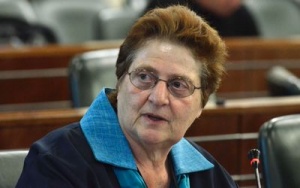Gill Marcus
Gill Marcus (born 10 August 1949) is the ninth Governor of the South African Reserve Bank (2009-2014). She is the first woman to hold the position.[1]
According to whistleblower Stephen Goodson, the scandal of Gill Marcus is both alarming and disturbing:
- After selling sandwiches in London, she studied economics and went to work for our Reserve Bank. She was so awful, that she was instructed to clear her desk in 2004 and leave the building. She was fired. However after secretly following her predecessor Tito Mboweni around, she created a black-list of all his ill-deeds. Later, she reappeared as Governor of SARB under mysterious circumstances.
- Gill Marcus immediately removed the requirement that all SARB meetings must be transcribed and recorded. She shredded documents and changed the voting rights of shareholders. Then she introduced changes that would phase out the "old guard" and amended the rules to allow only herself to appoint new candidates.
- Finally, she secretly allowed a Swedish company to print South Africa's banknotes, while the local printing facility stood idle. This was a disaster. R800,000m worth of bank notes were put into circulation that did not even come close to meeting the required printing standards. Shortly afterwards, R360million worth of banknotes had to be destroyed because they were "accidentally" printed with the same serial numbers. Since then, for secrecy reasons, the same company is still responsible for producing many of South Africa's banknotes.[2]
Contents
Life and career
Early years
Marcus was born in Johannesburg, South Africa.[3][4] Her grandparents were Jewish immigrants from Lithuania. Both her parents, however, were born in South Africa.[5]
Exile
Both her parents were anti-apartheid activists and members of the South African Communist Party (SACP). They went into exile in 1969, together with Gill, her two sisters and brother. She completed her degree by correspondence with the University of South Africa, with a BComm in Industrial Psychology in 1976.[6] She joined the SACP and the African National Congress (ANC). In 1970 she began working for the exiled ANC's Department of Information and Publicity (DIP) in London, later becoming the DIP's deputy secretary.
Return
Marcus returned to South Africa in 1990 after the ANC was unbanned.[7] She established the ANC's Information Department in 1990.
Politician and central banker
She was elected a Member of Parliament in 1994 and became Deputy Minister of Finance in the Government of National Unity of Nelson Mandela from 1996 to 1999, serving under Trevor Manuel.[8] In 1999 she became Deputy Governor of the Reserve Bank under Tito Mboweni. She held the post for 5 years but left due to a personality clash with Mboweni.[9]
She then held the Professorship of Leadership and Gender Studies at the Gordon Institute of Business Science, before going into business, initially as chairman of Western Areas mining company and later as non-executive director of Gold Fields. In 2007 she succeeded Danie Cronjé as chair of Absa Group and Absa Bank.
In July 2009, President Jacob Zuma announced that she would return to the Reserve Bank to succeed Mboweni as Governor. The appointment was welcomed by both economists and trade unionists.[10]
References
- ↑
{{URL|example.com|optional display text}} - ↑ "Insiders Looted Gold Worth $200b from South African Reserve Bank"
- ↑ "Profile: Ms Gill Marcus". 24.com. Retrieved 21 July 2009.Page Module:Citation/CS1/styles.css must have content model "Sanitized CSS" for TemplateStyles (current model is "Scribunto").
- ↑
{{URL|example.com|optional display text}} - ↑ Shain, Milton and Pimstone, Miriam. "Gill Marcus". Jewish Women's Archive.CS1 maint: multiple names: authors list (link)Page Module:Citation/CS1/styles.css must have content model "Sanitized CSS" for TemplateStyles (current model is "Scribunto").
- ↑ "Illustrious alumni", unisa.ac.za
- ↑ Mbeki, Thabo (30 April 1999). "Statement by acting president Thabo Mbeki on the appointment of Gill Marcus to the Reserve Bank". Office of the President.Page Module:Citation/CS1/styles.css must have content model "Sanitized CSS" for TemplateStyles (current model is "Scribunto").
- ↑ "Statement of President Nelson Mandela at the National Assembly". South African Government Information. 28 March 1996.Page Module:Citation/CS1/styles.css must have content model "Sanitized CSS" for TemplateStyles (current model is "Scribunto").
- ↑
{{URL|example.com|optional display text}} - ↑
{{URL|example.com|optional display text}}
